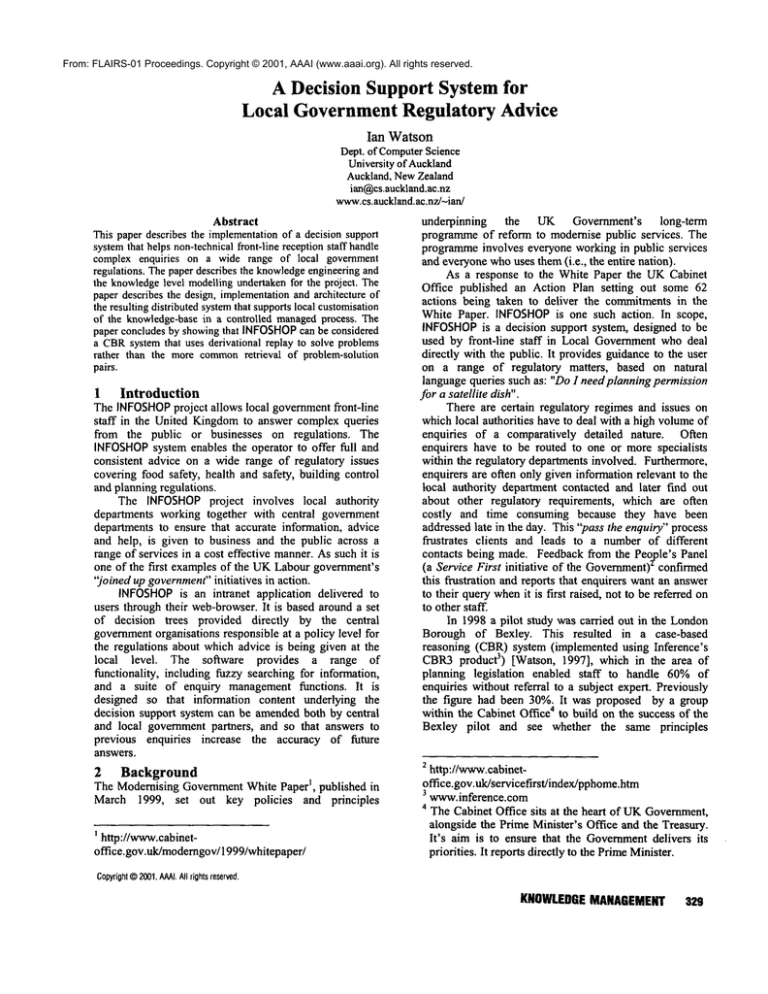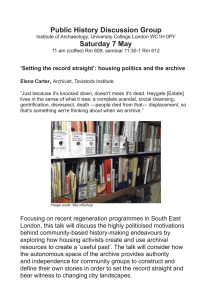
From: FLAIRS-01 Proceedings. Copyright © 2001, AAAI (www.aaai.org). All rights reserved.
A Decision Support System for
Local GovernmentRegulatory Advice
Ian Watson
Dept. of ComputerScience
University of Auckland
Auckland, NewZealand
ian@cs.auckland.ac.nz
www.cs.auckland.ac.nz/~ian/
Abstract
This paper describes the implementationof a decision support
systemthat helps non-technicalfront-line reception staff handle
complex enquiries on a wide range of local government
regulations. The paper describes the knowledgeengineering and
the knowledgelevel modelling undertaken for the prdject. The
paper describes the design, implementationand architecture of
the resulting distributed systemthat supports local customisation
of the knowledge-base in a controlled managedprocess. The
paper concludes by showing that INFOSHOP
can be considered
a CBRsystem that uses derivational replay to solve problems
rather than the more commonretrieval of problem-solution
pairs.
1
Introduction
The INFOSHOP
project allows local government front-line
staff in the United Kingdomto answer complex queries
from the public or businesses on regulations.
The
INFOSHOP
system enables the operator to offer full and
consistent advice on a wide range of regulatory issues
covering food safety, health and safety, building control
and planning regulations.
The INFOSHOPproject involves local authority
departments working together with central government
departments to ensure that accurate information, advice
and help, is given to business and the public across a
range of services in a cost effective manner. As such it is
one of the first examples of the UKLabour government’s
"joined up government"initiatives in action.
INFOSHOP
is an intranet application delivered to
users through their web-browser. It is based around a set
of decision trees provided directly by the central
governmentorganisations responsible at a policy level for
the regulations about which advice is being given at the
local level.
The software
provides
a range of
functionality, including fuzzy searching for information,
and a suite of enquiry management functions.
It is
designed so that information content underlying the
decision support system can be amended both by central
and local government partners, and so that answers to
previous enquiries increase the accuracy of future
underpinning
the UK Government’s
long-term
programme of reform to modernise public services. The
programme involves everyone working in public services
and everyone who uses them(i.e., the entire nation).
As a response to the White Paper the UKCabinet
Office published an Action Plan setting out some 62
actions being taken to deliver the commitments in the
White Paper. INFOSHOPis one such action. In scope,
INFOSHOP
is a decision support system, designed to be
used by front-line staff in Local Government who deal
directly with the public. It provides guidance to the user
on a range of regulatory matters, based on natural
language queries such as: "Do I need planning permission
Jbr a satellite dish".
There are certain regulatory regimes and issues on
which local authorities have to deal with a high volume of
enquiries of a comparatively detailed nature. Often
enquirers have to be routed to one or more specialists
within the regulatory departments involved. Furthermore,
enquirers are often only given information relevant to the
local authority department contacted and later find out
about other regulatory requirements, which are often
costly and time consuming because they have been
addressed late in the day. This "pass the enquiry" process
frustrates clients and leads to a number of different
contacts being made. Feedback from the People’s Panel
(a Service First initiative of the Government)+confirmed
this frustration and reports that enquirers want an answer
to their query whenit is first raised, not to be referred on
to other staff.
In 1998 a pilot study was carried out in the London
Borough of Bexley. This resulted
in a case-based
reasoning (CBR) system (implemented using Inference’s
CBR3product 3) [Watson, 1997], which in the area of
planning legislation
enabled staff to handle 60% of
enquiries without referral to a subject expert. Previously
the figure had been 30%. It was proposed by a group
within the Cabinet Office 4 to build on the success of the
Bexley pilot and see whether the same principles
answers.
2 Background
The Modernising Government White Paper t, published in
March 1999, set out key policies
and principles
= http://www.cabinetoffice.gov.uk/moderngov/1999/whitepaper/
2 http://www.cabinetoffice.gov.uk/servicefirst/index/pphome.htm
3 www.inference.com
4 The Cabinet Office sits at the heart of UKGovernment,
alongside the Prime Minister’s Office and the Treasury.
It’s aim is to ensure that the Governmentdelivers its
priorities. It reports directly to the PrimeMinister.
Copyright
© 2001.AAAI.All rights reserved.
KNOWLEDGEMANAGEMENT 329
underpinning that project could be used in other
regulatoryareas.
To this end the Cabinet Office bid to the Treasury’s
Invest to Save budget for £ 100,000(GBP)to support this
work, with approximatelymatching funds being provided
by the LocalAuthorities involved.
A project group at the Cabinet Office wasestablished
along with representatives from:
¯ Department for the Environment, Transport &
the Regions,
¯ Departmentof Health,
¯ Health &Safety Executive, and
¯ s,
Universityof galford
The followingLocalAuthorities joined the project to pilot
the system:
¯ Bamsley Metropolitan Borough Council
¯ London Borough of Bexley
¯ London Borough of Camden
¯ London Borough of Ealing
¯ Eden District Council
¯ KnowsleyMetropolitan BoroughCouncil
¯ Lincolnshire County Council & North Kesteven
District Council
¯ Norfolk CountyCouncil
¯ Reigate &Banstead BoroughCouncil
TeignbridgeDistrict Council
¯ LondonBorough of Tower Hamlets
¯ Thurrock BoroughCouncil
¯ Vale Royal BoroughCouncil
¯ LondonBorough of WalthamForest
For all involvedthis was the first time that so many
Local Authorities had collaborated on an IT project
together, and the first time that several Central
GovernmentDepartmentshad workedtogether with Local
Authority partners. It was this collaboration which was
the ethos of the Labour Government’s ’~]oined-up
government"
initiative.
3
Design Issues
The key design issue was to create a collaborative
environment. The purpose of bringing together central
governmentdepartments and Local Authorities was that a
single knowledge-basecould be created to cover national
regulations. However,this had to be customisable at a
local level in twoways.
Firstly, in manyinstances, and particularly in
planningregulation, there are significant local variations
in the application of legislation. Central government
departments set out policy which local government
interprets and applies within their owncontext. As a
consequenceregulations differ from one authority to the
5 The author was employedby the University of Salford
before movingto the University of Aucklandin early
2000and was a Central Partner of the INFOSHOP
project
providing advice on knowledgeengineering and other
technical matters.
330
FLAIRS-2001
next. Thus, the centrally provided knowledgebase would
have to be customisable by the Local Authority in a
controlled fashion without the need to employcostly
consultant knowledgeengineers or programmers.
Secondly, manyenquiries, whilst based on the same
legislation will result in different actions in different
authorities. For examplein one authority a request for
planning consent mayresult in forms being posted to the
client, whereasin another details maybe taken over the
phone, and in a third a case officer maybe instructed to
visit the property in question. Thus, even where the
legislation wasbeing interpreted and applied the samein
several authorities the resulting actions maydiffer.
Consequently,actions neededto be locally customisable.
The other main design consideration was one of cost.
Local Authorities do not have large IT budgets and have
manyfinancial and legal constraints on howrevenues can
be spent. As a consequence it was essential that
INFOSHOP
should run on standard PCs and not require
expensiveuser licences.
Linked to this was the budget for the project.
£100,000 had been obtained from the Treasury and a
contribution of approximately £6,500 was madeby each
of the Local Authorities giving a maximum
budget of
nearly £200,000. This sum had to cover all project
management expenses, knowledge engineering,
implementation,
the cost of softwarelicences for the pilot,
user training, evaluation and dissemination activities.
Given that the moneywas comingfrom public funds this
budget was fixed and non-negotiable.
4 Implementation
Althoughthe Bexley pilot had used a conversational CBR
system [Aha et al., 1998] the project team thought it
wrongto prejudge the technology whichmight eventually
be used to implement the INFOSHOPsystem. As a
consequencethe developmentof the systemwas split into
three distinct phases:
1. Knowledgeacquisition, which wouldresult in a
knowledgelevel [Newell, 1982] model of the
knowledgeintended for the system.
2.
Implementation, which would implement the
knowledgein the chosen technology and develop
the user interface.
3.
Evaluation, which would evaluate the pilot
systemin the field.
Furthermore, in the interests of objectivity it was
decided that phases 2 and 3 would not be performed by
the samecontractor or consultants.
An invitation to tender for phases 1 & 3 (either
separately or together) was advertised in early 1999. The
consultants PricewaterhouseCoopers
wonthe bid for both
phases 1 and 3.
4.1 Knowledge Acquisition
The project team decided that the INFOSHOP
should deal
with planningregulations (already partially coveredby
Category II
P14
~ Do
Planning
Planning permission
P14:DoI need planning
permission,ors satellite dish?
I need planning
permission
for a satellite
dish?
~._
~
~
/,I,
Pen’nis.~on
isrequit~d
if:
\
j)
~ Wh~mt~of
........
Buildingmorathan,15m
high
(about5 stones)
~
~
Ihig.u,,ding
I ".,h ~’_lS.m.
I (~.t5.sted.)
~oI
I
""M’°"e~’~
~
;
.
dishisgmaterth.~mg0cm
I Plannmgpermlss~on.
neededif it.
{ Pem’,:,ssionw~notbereq’&rad
I
dish is greeter than 45 cm(if idted on a~ e .xce. eds highes! point of mof/chmqney I
I unless:
chimneystack o¢ abovethe highest point"~T~ (wh,chevetepphes)
I
I dish is greater than 1.3m
on ¯ root)
|
lion area
I
I i ........
in a conservation
area.
.
~
Listed
building
consent
but
not
|
NB:if listed building thenLB
on ¯ chimneyor on a listed buidlng / Planning Permission
I consentwill be required
T
Note: thedishshouldbesRed(sofaras
~
....
practical)
to minimise the impact on the I
~’Will thAl’a ha~’-~
externalappearance
of the building ~ / .....
\
,,_
~
~’_’"_-’,~_-_%"~-~
_
I
"
No
.
~/
Pemlission
is requiredif:
dish is greatmthan 90 cm
in
¯
conservalJon
Note:the dish shouldbe idt~l (so far as
practical) to minimisethe impaclon the
extemsteppearanse
of the building
Note- removal:if listed building then LB
consent
will berequired
t
Yes
,
< co~elx,
a~on
~Yse
~ area?
~I
~
J
I
~
area
.... ~
PlanningPeml.l?lonis required
NB:if hsted.+building.then
LB
I consentwlUbe required
I
I
I
I,es
I
;
I PtonningPecmissionis~:luimd
I NB:if listed building thenLB
I consentwill be required
~
-
I
I
w
I Planning Permission is required I
NB:if listed building thenLB
It consentwill be required
/
I
I
J
DETRBooklet: Householdersplanning guide for Installation
of Satellite
Television Dishes
Figure I A decision tree from the planning domain
the Bexleypilot), building control, health and safety and
food safety. It was planned that the INFOSHOP
should be
able to handle the most common80%of enquiries from
the public. PricewaterhouseCooperstherefore set out to
interview each Local Authority to establish what were
their most commonquestions. These were then collated
from all the partners to identify the most frequently
occurring 80%.
Planning
Buildingcontrol
Foodsafety
Health and Safety
Total
51
35
79
67
232
Table 1. No. of Decision Trees per Regulatory Area
Knowledge engineering was then undertaken to
identify what knowledge was required to answer or
handle each question. A form was developed to capture
this information and PricewaterhouseCoopers modelled
this informationas decision trees, whichhave been widely
used as a concise and readable notation for decision
making knowledge [Longbottom & Wade, 1973; Motet,
1982]. A total of 232decision trees werecreated for the
four regulatory areas (note that several question were
often subsumedby one decision tree). The knowledge
engineering phase took approximatelythree months.
5 Implementation
An invitation to tender for the implementation of the
system was issued in May1999 and Tagish6, a company
with a strong track record in Local GovernmentIT work,
was selected as the contractor. A decision was taken by
Tagish to directly implementthe decision trees using the
7 Visio enables the content of the
flowcharting tool Visio.
decision trees (nodes and arcs) to be stored and indexed
in a database, whichcan be searched enabling the correct
tree to be retrieved froman initial natural languagequery.
Changes to individual trees can be made using the
flowcharting tool, which does not require any
programmingor knowledgeengineering experience. It
was hoped that providing proper versioning control was
implementedthis wouldsatisfy the local customisation
requirementfor the knowledgebase.
Lotus Notes was selected to store the database and
decision trees because it provides manyfeatures to
support collaborative working, versioning, security and
through Lotus’ DominoServer content is accessible via
the Internet or an Intranet. It was recognised that the
decision to use Lotus Notes did havea modestlicence fee
implication for the Local Authorities. However,this was
mitigated by the fact that only one Notes licence was
needed for the designated tree "author" within each
6 www.tagish.co.uk
7 www.microsofl.com/office/visio/
331
KNOWLEDGE
MANAGEMENT
authority plus one Notes Server and DominoServer
licence per authority
For the pilot Tagish wouldhold the master copy of
the knowledge base (the Master Trees). Each Local
Authority would hold a replicated copy on their own
server. Local changes to the knowledge-base would be
held locally but wouldalso be replicated back to Tagish
and stored separately. Whennational legislation changed
the Master Trees would be changed and this change
replicated to each LocalAuthority.
A management
structure was also put in place for the
Local Authorities to periodically meet and review the
changes they had independently madeto their trees so
best practice could be captured and propagated between
partners.
Answering"No" to the question in Figure 2 causes a
series of further questions to be asked. Arriving at a
conclusion (a leaf node in the tree) causes a pop-up
windowto launch stating the result that no planning
permissionis required providingthe satellite dish is sited
in such a way as to minimiseits impact on the external
appearanceof the building.
Dependingon the result required at each node, it can
cause documents, forms and standard letters to be
retrieved from a documentrepository system, client data
to be entered into booking,logging or tracking systemsor
faxes and emails to be sent to appropriate people. If a
successful solution cannot be obtained the consultation
can be logged, appropriate notes can be addedto it and it
can be referred to an appropriate personto deal with.
5.1
A Consultation
INFOSHOP
takes a natural language query and after
processinguses it to search the Notes database containing
the tree descriptions. Processingthe queryinvolves:
¯ removing noise words (commonterms of speech
suchas prepositions),
¯ removingplural wordforms,
¯
spell checking to automatically suggest
alternatives for unrecoguisedwords
¯ applying a user defined and locally customisable
lexicon to deal with commonsynonyms and
local dialect wordsspecific to one region.
Because the text matching algorithm cannot be 100%
accurate a set of candidatetrees is retrieved with the best
match being presented to the user and alternative
"relevant inquiry routes" being displayed should the best
matchprove incorrect
Figure 2 shows INIrOSHOP’sresponse to the well
formed query "Do I need planning permission for a
satellite dish". INFOSHOP
identifies the keywords
planning, permissionand satellite in the query (these are
highlighted in the centre left of the screen). This query
causes the retrieval of tree PI4. Trees P83, P84, P82 and
P80 have also been identified as relevant to this enquiry
(these are listed in the bottomright panel of the screen).
The retrieval of tree P14 results in the question "Is it a
listed building... ’’8 (shownin the top left panel of the
screen - i.e., the region of the screen the user first looks
at). If the answer to this question is yes, then Listed
BuildingsConsentis required regardless of the location of
the building the size, position or numberof satellite
dishes.
Also of interest in Figure 3 is the "Makean annotation"
button. At any time the user can click this and makean
annotation. These might be used by to record notes for
tree authors to suggest changes or to commentthe
legislation to improvethe ease of future use.
6
Conclusion
LocalAuthorities are able to author the decision trees as
intended, and the usability of the systemhas beenpraised
by several LocalAuthorities.
"Ourreceptionservice is the front line for all
services provided by the EnvironmentDepartment.
I am impressed with how user friendly INFOSHOP
is. Also, our pilot has madea soundstart in
beginning to reduce those high frequency standard
regulatory calls normallydealt with by Technical
Officers. Receptioncolleaguescan nowdeal with
someof these".
[RudyBright, Records&Information Manager,
London Borough of Camden]
"INFOSHOP,
fully utilised will be a very powerful
tool Camden
decidedto go for it, warts andall~ I
ampleased with the start we have madealthough
we all agree moredevelopmentworkis needed.
Camden’sINFOSHOP
has been adapted to prompt
reception colleaguesaboutleaflets andother
documentsthat could also be sent out to the
enquirer. Furtherworkwill makethis into a
comprehensiveinformation service."
[Paschal O’Neil, Decision Tree Author, London
Borough of Camden]
From an AI perspective INFOSHOP
demonstrates
that it is not alwaysnecessaryor appropriate to use an AI
tool to develop and deliver AI solutions. The design
requirementthat Local Authority staff be able to easily
customise the knowledge base meant that many more
"sophisticatear’ tools were not suitable. However,
decision trees as a knowledge level representation
[Newell, 1982] were ideal, enabling the authors to worry
about documentinglegislation and not programming
code.
Moreoverthe use of Lotus Note’s sophisticated version
control, replication and security features made the
distributed yet controlled roll out and maintenanceof the
INFOSHOP
feasible.
Althoughit was decided not to use a CBRtool for
the solution, even thoughit had provedsuccessful in the
Bexley pilot, this does not meanthat CBRas a problem
solving methodologywas rejected, quite the contrary.
INFOSHOP
retrieves the best matchingdecision tree from
s Listed buildings in the UKare of historical or
architectural significance and are covered by strict
regulations.
332
FLAIRS-2001
its database(i.e., the mostsimilarcase) andthenuses the
retrieved tree to solve the problem.
mltmP
In CBRterminology this is derivational replay
[Mostow& Fisher, 1989]. Where cases store problem
descriptions and a problemsolving method, which can be
reused (i.e., replayed) to solve the problem. This
distinct from most CBRsystems which store pairs of
problem descriptions and their solution. The main
advantageof derivational replay is that fewer cases need
to be stored since each problem solving method can
usually cover a wide range of input criteria.The
disadvantage is that you need to understand the domain
theory, in order to be able to create problem solving
methods.
INFOSHOP
also has facilities to acquire newproblem
solving cases through the customisation and addition of
trees (i.e., the revise and retain stages of the CBR-cycle
[Aamodt & Plaza, 1994]). Thus, INFOSHOP
further
demonstrates the omnipresence of CBRin problem
solving [Aha, 1998] and is a practical demonstrationthat
CBRis a methodology for problem solving not a
technology [Watson, 1999], since INFOSHOP
doesn’t use
any of the technologies, such as k-nearest neighbour, so
frequently associated with CBR.
The managementof INFOSHOP
has now passed from
the incubator of the Cabinet Office to the Small Business
Service 9, an agency of the Department of Trade an
Industry that aims to improvethe regulatory environment
for small businesses, and to ensure that all small
businesses have access to world class business support
services.
9 www.dti.gov.uk/sbs/sec
1 .htm and
www.businessadviceonline.org
On the 19t~ April 2000 INFOSHOP
won the UK
GovernmentInnovation Award2000.
7
References
Aamodt,E. &Plaza E. (1994). Case-BasedReasoning:
FoundationalIssues, MethodologicalVariations, and
SystemApproachesAICom
- Artificial Intelligence
Communications,
IOSPress, Vol. 7: l, pp. 39-59.
Aha, D. W.(1998). The Omnipresenceof Case-Based
Reasoningin Science and Application. KnowledgeBased Systems, 11(5-6), 261-273
Aha, D.W., Maney,T., &Breslow, L. A. (1998).
Supportingdialogue inferencing in conversational
case-based reasoning. Fourth EuropeanWorkshopon
Case-BasedReasoning(pp. 262--273). Dublin, Ireland:
Springer.
LongbottomD, WadeG. (1973). Aninvestigation into the
application of decision analysis in United Kingdom
companies.Omega,vol. 1, no.2, pp.207-15. UK
MoretB.M.E.(1982). Decision trees and diagrams.
Computing
Surveys, vol. 14, no.4, Dec. 1982, pp.59362.
Mostow,G., &Fisher, G. (1989). Replaying
TransformationalDerivations of Heuristic Search
Algorithms in DIOGENES.
In, Proceedings of the
DARPACase-Based Reasoning Workshop, Hammond,
K.J. (Ed.), MorganKaufmann,Calif., US.
Newell,A. (1982). The knowledgelevel. Artificial
Intelligence, vol. 18, no. 1, Jan. 1982,pp.87-127.
Watson,I. (I 997). ApplyingCase-BasedReasoning:
techniques for enterprise systems. MorganKaufmann
Inc.
Watson,I. (1999). Case-BasedReasoningis
methodologynot a technology. KnowledgeBased
SystemsJournal Vol. 12 no.5-6, Oct. 1999, pp.303-8.
Elsevier, UK.
KNOWLEDGE
MANAGEMENT 333






